Boeing, after a month of repeated delays and technical problems, has finally launched its first crewed flight on June 5, aboard its Starliner ship.
The launch was initiated atop an Atlas V rocket at 10:52 a.m. from NASA's Cape Canaveral Space Force Station, Florida, as the aerospace manufacturer delivered its two astronauts to the International Space Station.

NASA officials said the Starliner mission did not encounter any problems this time. The whole flight sequence can be watched via NASA's official YouTube channel.
The flight, originally scheduled on May 6, was first canceled after Boeing engineers detected a valve issue hours before launch.
A second attempt was also later canned following a helium leak in one of the Atlas rocket thrusters, rescheduling the test flight in early June.
According to Space.com, repeated delays have already been expected as NASA and Boeing prioritize the astronauts' safety over schedules.
Also Read: Boeing Starliner Flight Delayed Again; No Relaunch Date This Time
What's Next for Boeing?
Astronauts Suni Williams and Butch Wilmore are set to arrive at the ISS on Thursday afternoon, where they will stay for about a week attached to the space station.
The week-long flight mission will help determine NASA and Boeing if the capsule's suitability in the vacuum of space.
If all goes well, NASA would finally grant Boeing permission for regular crewed space missions, an order its competitor SpaceX received two years ago.
It can be remembered that NASA gave cash grants to Boeing and SpaceX in 2014 as the space agency moved to revive plans to bring Americans back to the moon via the Artemis missions.
Related Article : Boeing's First Crewed Flight Postponed Due to Valve Problem
NASA Targets to Increase Space Missions for 2024, 2025
With Boeing's and SpaceX's current progress, NASA is set to expand operations as it gears up for more lunar and space missions in the upcoming years.
NASA is already poised for a September 2025 goal to launch its Artemis II mission, a four-crewed flight that will orbit around the moon.
This will be followed by the Artemis III and IV missions that will finally land astronauts near the moon's South Pole and establish the Gateway lunar space station.
The missions remain scheduled to be completed by 2028.









